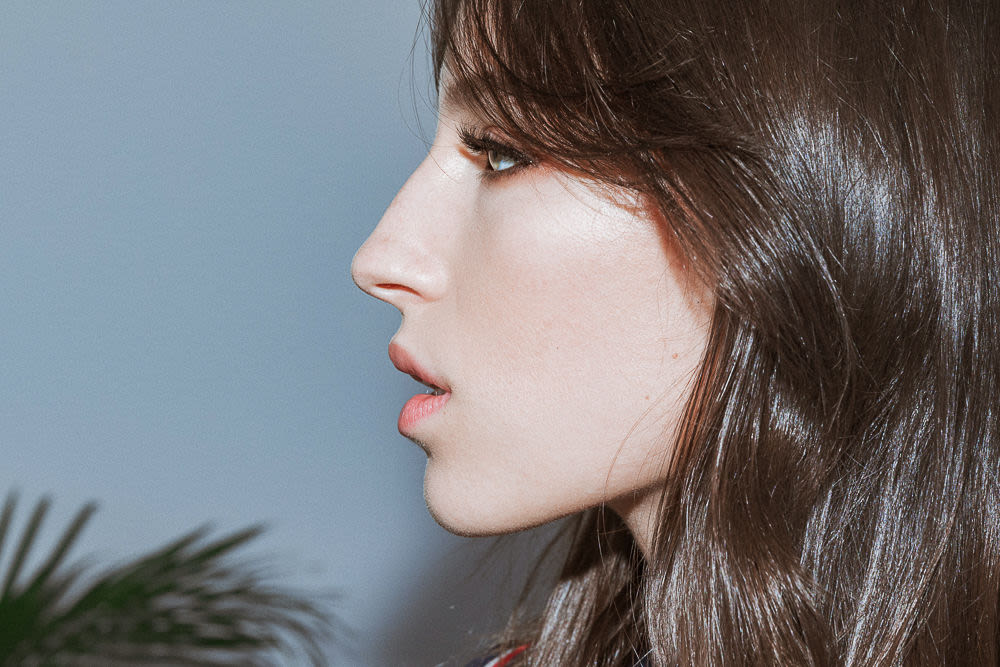A week ago, I found myself at an appointment where over a hundred tiny fragments of silk were being permanently glued to my face. I was getting lash extensions, as I had a dozen times or so already, and I was getting them for all the usual reasons: they make my life easier and they look good. Nothing—not mascara, or tinting, or lifting—comes close to how good they look. Urban folklore will have you believe that extensions make your natural lashes fall out more easily, but the truth is that a good set is like a protective style for the lashes you already have—you’ll be more gentle with them and, underneath the extensions, lashes can grow longer and stronger. The fact that they’ll look absolutely incredible is a welcome side effect.
I sung the praises of my extensions a month ago, and it turns out you had questions. Too many to answer in one comment thread, in fact. So I enlisted the help of Jasmine Imani, the Soho-based lash artist favored by beauty insiders Ashley Graham, Rio Viera-Newton and Julie Schott, and started sorting through them. The result is everything you need to know about lash extensions—where to go, what to ask for, and how to keep your lashes their longest, healthiest best.
Before you go
Check to see if you are a good extensions candidate.“Extensions should not be used to cover up your damaged lashes,” says Jasmine. “You should not be getting them if your lashes aren’t strong and healthy.” Doing so may cause your natural lashes to fall out faster, due to the extensions’ extra weight. If your lashes are weak or sparse, Jasmine recommends starting a lash serum regimen until they’re strong enough for extensions.
Vet your aesthetician. Referrals from friends are always helpful, but they’re not always easy to come by. On your own, it can be tricky to determine whether a lash salon is safe—and a tempting Groupon deal doesn’t make that any easier. For a service involving chemicals so close to your eyes, you’re better off spending a few extra bucks than facing the consequences of shoddy lash application. The most important thing, Jasmine stresses, is that your lash technician be a licensed aesthetician. (To comply with state law, their license should be either visible or available upon inquiry.) If you’re getting lashes done in your home or in the home of your technician, it’s even more important to ask—some people try to work around the license laws by providing at-home extension services. “Other certifications and trainings don’t mean much, and unless your technician wants to state what products they use, there’s no way to tell.” Imani tells me new products are constantly coming out—she looks for new ones weekly. But one thing she says hasn’t changed much is price. “Your glue should be the most expensive thing your artist purchases,” she explains, which means that less expensive extensions can mean less money spent ensuring the glue used is safe and effective. “If someone is charging below the market rate, I might think twice about having them work near my eyes.” While the market rate varies from place to place, in New York it’s no less than $100 for a set.
Prep your lashes. Stop using waterproof mascara and oil-based makeup removers 48 hours before your appointment. “Certain products can mess with the pH of your lashes and therefore the glue. That chemical difference can cause it to not stick properly,” Imani explains. She also suggests ditching the eyelash curlers around that mark: the kinks they leave can make it harder for your technician to apply extensions cleanly to the natural lash. The day of your appointment, arrive with no eye makeup. And Imani also suggests washing your hair that morning, because you won’t be able to get your fresh lashes wet or steamy for 24 hours.
Choosing your lashes
After arriving for your appointment, you’ll be asked to make a series of choices about your extensions. Here’s where you choose the best set for you.
Lash length: You want longer lashes, but how long is too long? It can be difficult to tell when looking at a diagram of lash lengths. “For length I wouldn’t do past 13mm,” recommends Imani. “Using a variety of lengths makes the extensions look more natural—the little lashes closest to the inner corners of your eyes are shorter than the ones in the center of your lash line, and your extensions should replicate that effect. The length you choose is totally down to personal preference. I like to go for a 13mm lash, because if I’m paying through the nose for my extensions I want them to be long.
Curl shape: After you’ve picked your length, you’ll decide on a curl shape. Lashes usually come in four different levels of curl: J, B, C, and D. The most subtle is a J-curl—these curl slightly at the end and add length more than curl. If you’re hesitant about lash extensions, or worried about them looking too intense, a J curl is the easiest place to start. On the other end of that, a D curl is the most dramatic lash shape. But don’t let that deter you from them—again, depending on your other choices, more curl can look totally natural. A D is actually my favorite lash. You can’t curl your lashes once your extensions are applied, so if you’re after a permanent curl, you’ll be happiest with a C or D.
Lash amount: While Imani tailors each of her extension designs to her clients individually—no counting lashes—most salons price extensions based on how many you want. JJ Lashes, a popular New York-based lash salon, offers sets of 80, 100, and 120 lashes per eye. For natural looking extensions, you’ll be happiest with 80 lashes or fewer (I get a set of 60) per eye. The reason you might opt for more is a special occasion, like a wedding or photoshoot.
Material: The most popular options are synthetic, silk, and mink—which, surprisingly, are all types of synthetic lashes. Imani clarifies that some synthetic lashes are better than others—instead of referring to animal products, “silk” and “mink” are just ways of distinguishing different quality grades of synthetics. Synthetic silk and mink lashes hold their curls better than the real thing, and have the added bonus of being cruelty free and hypoallergenic. Between them, the decision comes down to budget (in most lash salons, mink is usually more expensive) and personal preference. “Silk lashes give more of a sheen while mink is more matte,” says Imani. She cites skin tone, natural hair color and occasion as factors in choosing which is best.
Round or flat lash: Recently, some lash salons have started offering flat lashes. Instead of rounding at the base, they have a more elliptical shape that helps them sit closer to the natural lash, but look wider and fuller at the lash line. “They give a heavier look that’s more dramatic and not very natural,” Imani explains. This one comes down to personal preference, but Imani isn’t a fan.
Color: Most people who get extensions are looking to forgo mascara—so you’ll want extensions that are a dark, inky black. And though black is the most popular, “lash extensions actually come in all colors,” says Imani. “For someone who is very blond and wants a natural look, it is nice to go with dark brown.” Alternatively, consider tinting your lashes a few days before getting extensions. For those with light or red hair, tinting will blend your extensions in with your natural lashes (and bottom lashes!) a lot better.
Lash pattern: The usual options are natural (lashes follow your natural lash pattern), round (longer lashes in the center of the eye), and cat eye (longer lashes in the outer corners). You’ll choose based on the shape of your eye and what you’re trying to accentuate, but the most natural-looking option is always… natural.
The process
Lashes take at least one hour to apply, so be sure to bring headphones and have your favorite podcast queued up. Your technician will cover your lower lashes, and you’ll have to keep your eyes closed for the duration of the appointment. You can feel as your technician separates and brushes your lashes, but the process shouldn’t be painful. (If you feel any pain, burning, or stinging, notify your technician immediately.) At worst it’s boring and at best, relaxing—I’ve certainly fallen asleep at times.
Lash aftercare
Don’t use oil-based makeup removers or cleansers near the eye area, as they’ll dissolve the glue—you can wear eye makeup, but you’ll have to remove it gently. Imani also recommends using a lash serum while wearing extensions, and to brush your lashes daily with a spoolie. Most lash places will suggest fills every two to three weeks, but I’ve found that a well-applied set of extensions can look good for upwards of a month. People in this forum thread recommend wearing goggles to protect your lashes when you cleanse or shower, but extreme measures are unnecessary. I’ve gotten them before beach vacations, and even swimming in the ocean or chlorine pools didn’t make them fall out any faster. I still use eye cream and facial oil, and even oil cleanser from time to time, but I make sure not to rub the oils into my eyes. Lash extensions are meant to make your life easier—I live business as usual.
Remember, your lashes fall out naturally—it’s easy to panic when long, curly lashes suddenly litter your pillowcase, but you’re just noticing them more because they’re more visible. When most of them have fallen out, or the lash has grown out and the extension is no longer at its base, it’s a sign to go back for a new set. “Lashes should be getting a break while wearing extensions,” emphasizes Imani, which means no curling, no mascara, and NO PICKING.
If you’re unhappy with your lash set, go back to the salon and have a pro take them off. No exceptions! If you don’t trust the place you went to to do a good job, you can go to any lash pro to do it—but they might charge you a fee. Even if a bad set (subpar glue, improper application technique, you picked them all off) does leave you with sparse lashes, Imani stresses that it’s not the end of the world. “Luckily,” she explains, “your lashes replace themselves every six to eight weeks.” And for those times, there’s always mascara.
—Ali Oshinsky
Photo via ITG

